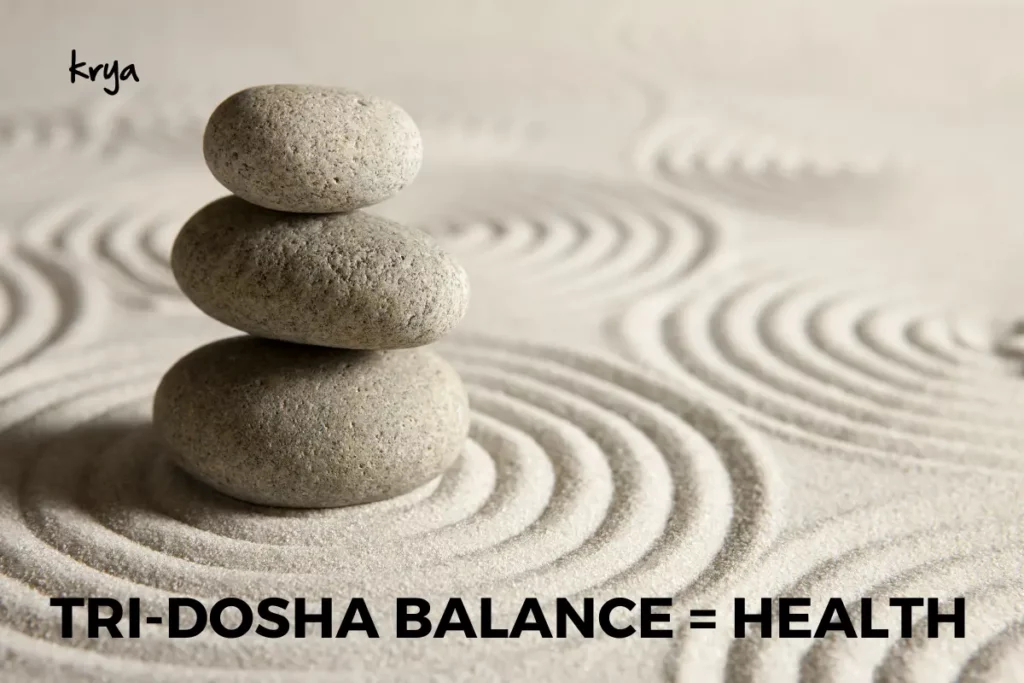This post was last updated on August 5, 2023 by Preethi Sukumaran
The Three Doshas in Ayurveda
The building blocks of the Human body are Vata dosha , Pitta dosha & Kapha dosha. This Tridosha principle is a very important fundamental concept in Ayurveda
Naturally this concept leads to many questions – What is Pitta dosha ? What is Vata Dosha? How do these doshas determine our health ? etc
In this post we will study pitta dosha in detail , based on authentic references from the classical Ayurvedic texts
Dosha Balance leads to Health
We are all born with a particular combination of Vata,pitta & kapha doshas. Due to various factors, doshas can increase(vriddhi) or decrease (kshaya). This increase or decrease in doshas is commonly known as aggravation.
When the three doshas are in balance (Samya) then our body is in a state of health. When the doshas are aggravated, it can become a cause of diseases.

Pitta Dosha Characteristics

Pitta dosha is commonly referred to as the “fire” element in our body.
The three doshas themselves are created from the five fundamental elements of space, air, earth, fire and water
Specifically, Pitta dosha is created by the combination of fire & water. This is why Pitta dosha represents the “fire” element in our body. Later on, when we discuss Pitta balancing foods, it would be very clear why we have to avoid fiery, spicy items in order to control pitta dosha.
The complete list of characteristics of Pitta dosha as defined in the texts are – Ushna (hot, heat producing), Slightly unctuous(oily), Teekshana (penetrating), laghu (light), Visra( produces bad smell), sara (causes movement) and dravya (liquid)
Some of the above characteristics of pitta dosha are easy to understand when we remember that pitta is created by combining fire and water elements. Some other characteristics like oiliness or odour producing are not very intuitive and therefore very useful to know. This is why people who have a dominant pitta characteristic can suffer from high body odour or oily scalp
Functions of Normal Pitta Dosha
All the 3 doshas have very unique and critical functions when they are in their natural state
Pitta dosha is responsible for sustaining our bodies with digestion, heat production, desire, hunger, thirst, colour and complexion (of the skin), intelligence, courage etc
The “seat” of the Dosha
All the three doshas are present in every cell of the body, they have certain predominant areas known as the “seat” of the Dosha
Pitta dosha is predominantly found in the region between heart and the umbilicus. One of the very important functions of pitta dosha is to create the digestive fire, responsible for proper digestion of our food

The Time & Space effect of Doshas
Different parts of the day and night are dominated by one of the three doshas, which again has an impact on our bodies. Based on the movement of the Sun, the middle part of the day & the period around midnight are dominated by Pitta dosha. This is why we feel the most hunger in the midday period when the Sun’s “fire” energy is at it’s peak. Likewise due to the higher Pitta energy of the midnight period, we often get late night hunger pangs, if we stay up late at night
The 24-hour day can be divided into 6 parts of 4 hours each. And each 4-hour period is dominated by one of the three doshas. This is the Ayurvedic clock concept, which is also very useful to get a better understanding of Ayurvedic health principles.
Dosha Accumulation & Aggravation in certain seasons
Doshas also accumulate naturally in certain seasons. For example in Varsha Ritu (monsoon, Pitta attains sanchaya or begins accumulating. It attains prakopa or full stage of natural aggravation in Sharad Ritu.
Similarly, Varsha attains sanchaya in Greeshma Ritu and Prakopa in Varsha Ritu
Therefore Ritucharya takes these into account and each set of seasonal Ritucharya guidelines pays emphasis on specific dosha balancing measures depending on which dosha is being accumulated and which one is being aggravated.
The Lifestage Effect of Doshas

To support the different goals of human life, each dosha is naturally dominant in each phase of life. The main aim of the childhood phase, from birth till our 20’s is the full and proper development of our body. So childhood and young adulthood phase are dominated by Kapha dosha, to support growth
The middle part of life, or the middle ages are dominated by pitta dosha. Pitta dosha also helps develop leadership and decision making skills. These are vital in the middle phase of life, when we have significant family and financial responsibilities.
It must be noted that this life-stage based dosha predominance is common for all of us and is an additional factor, over and above our unique prakriti
The Five divisions of Pitta Dosha
All the three doshas are further divided into 5 distinct types of sub-doshas
Pitta dosha is subdivided into Pacaka, Ranjaka, Sadhaka, Alocaka & Bhrajaka pitta respectively
Each of these 5 subdivisions of pitta reside in different parts of the body and are responsible for a specific function of the overall Pitta dosha
For example Alocaka pitta is situated in the eyes and is responsible for our sight
Bhrajaka pitta is located in the skin. It is responsible for colour & the lustre of our skin. When we use products on our skin like a good Abhynga oil or ubtan, the Bhrajaka pitta helps to absorb(digest) the herbs and oils in the product. This is turn helps to keep the skin soft, supple and imparts lustre (complexion)
At Krya we place great emphasis on choosing the right herbs that improve the functioning of the Bhrajaka pitta and therefore enhance your skin health.
Therefore a good understanding of the pitta dosha symptoms on skin, is a essential part of formulating skin care products that work really well
Aggravated Pitta dosha Symptoms
A dosha can get aggravated or imbalanced due to food, lifestyle, stress and many other factors
For example, if you eat a very hot spicy meal, high in chillies or go out for a long time in the hot midday sun, you increase the heat and fire elements in your body. This is an example of pitta dosha imbalance due to increased pitta levels
It is also possible to have Pitta Kshaya or decreased Pitta levels in the body. This can be detected by low appetite, decrease in body temperature, pale lacklustre skin etc.

Aggravated (increased) Pitta Dosha Symptoms include
- Desire for cold comforts
- Burning sensation
- Bitter taste in the mouth
- Anger
- Thirst
- Mild descrease in ojas
- Tiredness
- Weakness of the sense organs
- Yellow coloration of the skin
- Less Sleep
Aggravated Pitta dosha symptoms on skin
- Skin has a “flushed” appearance
- Skin is sensitive and reacts easily to cosmetics, fragrances, coarse textures and heat
- Skin easily gets red and inflamed
- Aggravated pitta-type skin may be a little thinner that the Kapha types skin
Aggravated Pitta dosha symptoms on Hair & Scalp
- Scalp oiliness despite regular washing. As we saw earlier, two core qualities of pitta dosha are slightly oily & fluidity. So when aggravated, scalp is oily and often sweaty
- Naturally black hair can become reddish brown in appearance, when seen in sunlight, due to aggravated pitta
- Premature greying is very common result of aggravated pitta dosha
- Pitta type hair is thinner to start with and highly aggravated pitta dosha can lead to Hair thinning and baldness
How to balance Pitta Dosha

The treatment of aggravated Pitta dosha is a vast and technical subject. You should always consult with a good Vaidya to understand your specific needs. The concepts discussed here are only to provide a general introduction.
Aggravated pitta dosha is balanced by intake of ghee, application of ghee on the body, use of foods and herbs that have sweet, bitter and astringent rasa (taste), use of natural perfumes that have mild , cool and pleasant effects, wearing garlands of flowers and gems like lotus, jasmine or pearls, spraying the body with cool water infused with herbs, exposure to moonlight, listening to mild, pleasant instrumental music, and spending time in hills and near water bodies.
There are also specific internal medicines too described in the texts to balance the doshas as part of medical treatments
Pitta Balancing foods and diet
We have written two detailed blog posts on a diet to balance pitta dosha. You can read the posts here & here
Summary
This post has been written as a general introduction to Pitta dosha as part of our Ayurveda basics series. We hope you now have a good understanding of what is Pitta dosha, its characteristics, functions and how to balance aggravated pitta dosha
The Krya After-sun range helps balance skin conditions due to aggravated pitta dosha. The classic plus range helps with hair thinning and high greying which are caused by pitta dosha imbalance. The Krya Classic Abhyanga oil is an excellent product for regular abhyanga that also helps with balancing pitta dosha
In case you need help with selecting krya products, email us at [email protected] or whatsapp us
References
The Primary reference for this article is the Classical Ayurvedic textbook from the 7th Century CE , Ashtanga Samgraha by Acharya Vaghbhatta. The particular edition referred to was written by Prof KR Srikantha Murthy, with original text & translations, published by Chaukambha Orientalia, Varanasi




